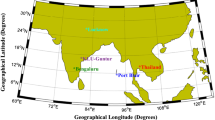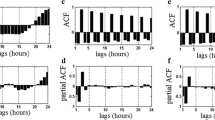Abstract
Continuous monitoring of ionospheric behavior and subsequent development or improvement of models for the prediction of its parameters with consistent accuracy remains an ongoing challenge. In this sense, an integrated approach by combining the signal extraction technique Singular Spectrum Analysis (SSA) with Autoregressive Moving Average (ARMA) is presented in this work to predict the ionospheric Total Electron Content (TEC) values that are responsible for causing ionospheric delays in the trans-ionospheric signal propagation associated with satellite-based communication, navigation, and timing applications. In general, SSA is a nonparametric spectral estimation procedure that decomposes the signals into interpretable and physically significant components. The observed TEC from two Global Positioning System (GPS) stations across the low latitude Saudi Arabian region are considered during the year 2017 that falls in the descending phase of solar cycle-24. The performance of the proposed hybrid model is evaluated by comparing with the sole estimation from the ARMA model and the observed GPS–TEC dataset for two different geomagnetic conditions: a) the regular geomagnetically quiet period of 15 to 29 December, 2017 (\(\text{Ap} < 24\) and \(\text{Dst} > -30\) nT) and b) the geomagnetic storm period from 7 to 9 September, 2017 (\(\text{Dst} \min = -142\) nT). The corresponding average Precision, Mean Absolute Error (MAE), and Mean Absolute Percentage Error (MAPE) of the proposed SSA–ARMA model predictions are 1.79 TECU, 1.23 TECU, and 13.02%. In contrast, the respective values in the exclusive ARMA model are 2.01 TECU, 1.37 TECU, 14.42% at Oman station. The corresponding values for Magna station are 0.92 TECU, 0.61 TECU, and 10.76% (SSA–ARMA) and 1.01 TECU, 0.75 TECU, and 11.33% (ARMA). The results show an improved computational efficiency with minor improvement in the TEC predictions with the proposed SSA–ARMA method compared to the sole employment of the ARMA model by disregarding the extraneous components.








Similar content being viewed by others
References
Adewale, A.O., Oyeyemi, E.O., Olwendo, J.: Solar activity dependence of total electron content derived from GPS observations over Mbarara. Adv. Space Res. 50, 415–426 (2012)
Ansari, K.: Real-time positioning based on Kalman filter and implication of singular spectrum analysis. IEEE Geosci. Remote Sens. Lett. 18(1), 20321896 (2020)
Ansari, K., Panda, S.K., Althuwaynee, O.F., Corumluoglu, O.: Ionospheric TEC from the Turkish permanent GNSS network (TPGN) and comparison with ARMA and IRI models. Astrophys. Space Sci. 362, 178 (2017)
Ansari, K., Panda, S.K., Corumluoglu, O.: Mathematical modelling of ionospheric TEC from Turkish permanent GNSS network (TPGN) observables during 2009–2017 and predictability of NeQuick and Kriging models. Astrophys. Space Sci. 363, 42 (2018)
Ansari, K., Park, K.-D., Kubo, N.: Linear time-series modeling of the GNSS based TEC variations over Southwest Japan during 2011–2018 and comparison against ARMA and GIM models. Acta Astronaut. 165, 248–258 (2019a)
Ansari, K., Park, K.-D., Panda, S.K.: Empirical orthogonal function analysis and modeling of ionospheric TEC over South Korean region. Acta Astronaut. 161, 313–324 (2019b)
Ansari, K., Panda, S.K., Jamjareegulgarn, P.: Singular spectrum analysis of GPS derived ionospheric TEC variations over Nepal during the low solar activity period. Acta Astronaut. 169, 216–223 (2020)
Atıcı, R., Sağır, S.: Global investigation of the ionospheric irregularities during the severe geomagnetic storm on September 7–8, 2017. Geod. Geodyn. 11, 211–221 (2020)
Bhardwaj, S., Chandrasekhar, E., Padiyar, P., Gadre, V.M.: A comparative study of wavelet-based ANN and classical techniques for geophysical time-series forecasting. Comput. Geosci. 138, 104461 (2020)
Dabbakuti, J.R.K.K., Peesapati, R., Panda, S., Thummala, S.: Modeling and analysis of ionospheric TEC variability from GPS–TEC measurements using SSA model during 24th solar cycle. Acta Astronaut. (2020). https://doi.org/10.1016/j.actaastro.2020.08.034.
Dabbakuti, J.R.K.K., Peesapati, R., Panda, S.K., Thummala, S.: Modeling and analysis of ionospheric TEC variability from GPS–TEC measurements using SSA model during 24th solar cycle. Acta Astronaut. 178, 24–35 (2021)
Goodman, J.M.: Operational communication systems and relationships to the ionosphere and space weather. Adv. Space Res. 36, 2241–2252 (2005)
Gopi, S.: Rinex GPS-TEC program, version 1.45. Boston College (2010)
Imtiaz, N., Younas, W., Khan, M.: Response of the low-to mid-latitude ionosphere to the geomagnetic storm of September 2017, 359–372 (2020)
Jamjareegulgarn, P., Ansari, K., Ameer, A.: Empirical orthogonal function modelling of total electron content over Nepal and comparison with global ionospheric models. Acta Astronaut. 177, 497–507 (2020)
Kumar, M.R., Sridhar, M., Ratnam, D.V., Harsha, P.B.S., Sri, S.N.: Estimation of ionospheric gradients and vertical total electron content using dual-frequency NAVIC measurements. Astrophys. Space Sci. 364, 49 (2019)
Mukesh, R., Karthikeyan, V., Soma, P., Sindhu, P.: Analysis of signal strength, satellite visibility, position accuracy and ionospheric TEC estimation of IRNSS. Astrophys. Space Sci. 364, 1–34 (2019a)
Mukesh, R., Karthikeyan, V., Soma, P., Sindhu, P.: Cokriging based statistical approximation model for forecasting ionospheric VTEC during high solar activity and storm days. Astrophys. Space Sci. 364, 1–11 (2019b)
Mukesh, R., Soma, P., Karthikeyan, V., Sindhu, P.: Prediction of ionospheric vertical total electron content from GPS data using ordinary kriging-based surrogate model. Astrophys. Space Sci. 364, 15 (2019c)
Mukesh, R., Karthikeyan, V., Soma, P., Sindhu, P.: Forecasting of ionospheric TEC for different latitudes, seasons and solar activity conditions based on OKSM. Astrophys. Space Sci. 365, 1–23 (2020)
Neeli, R., Dabbakuti, J.K., Chowdhary, V.R., Tripathi, N.K., Devanaboyina, V.R.: Modeling of local ionospheric time varying characteristics based on singular value decomposition over low-latitude GPS stations. Astrophys. Space Sci. 363, 182 (2018)
Ratnam, D.V., Sivavaraprasad, G., Devi, N.L.: Analysis of ionosphere variability over low-latitude GNSS stations during 24th solar maximum period. Adv. Space Res. 60, 419–434 (2017)
Reddybattula, K.D., Panda, S.K., Ansari, K., Peddi, V.S.R.: Analysis of ionospheric TEC from GPS, GIM and global ionosphere models during moderate, strong, and extreme geomagnetic storms over Indian region. Acta Astronaut. 161, 283–292 (2019)
Reddybattula, K.D., Panda, S.K., Sharma, S.K., Singh, A.K., Kurnala, K., Haritha, C.S., Wuyyuru, S.: Anomaly effects of 6–10 September 2017 solar flares on ionospheric total electron content over Saudi Arabian low latitudes. Acta Astronaut. 177, 332–340 (2020)
Sivavaraprasad, G., Ratnam, D.V.: Short-term forecasting of ionospheric total electron content over a low-latitude global navigation satellite system station. IET Radar Sonar Navig. 11, 1309–1320 (2017)
Sridhar, M., Ratnam, D.V., Raju, K.P., Praharsha, D.S., Saathvika, K.: Ionospheric scintillation forecasting model based on NN-PSO technique. Astrophys. Space Sci. 362, 166 (2017)
Suraj, P.S., Dabbakuti, J.K., Chowdhary, V.R., Tripathi, N.K., Ratnam, D.V.: Linear time series modeling of GPS-derived TEC observations over the Indo-Thailand region. J. Geod. 2017, 1–10 (2017)
Wintoft, P., Cander, L.R.: Ionospheric foF2 storm forecasting using neural networks. Phys. Chem. Earth, Part C, Sol.-Terr. Planet. Sci. 25, 267–273 (2000)
Zhang, D., Ridley, A.J., Xiao, Z., Hao, Y.: A global model: empirical orthogonal function analysis of total electron content 1999–2009 data. J. Geophys. Res. Space Phys. 117, A03328 (2012)
Acknowledgements
The GPS observation data was downloaded from the CDDIS NASA server (ftp://cddis.gsfc.nasa.gov/).
Author information
Authors and Affiliations
Corresponding author
Additional information
Publisher’s Note
Springer Nature remains neutral with regard to jurisdictional claims in published maps and institutional affiliations.
Rights and permissions
About this article
Cite this article
Dabbakuti, J.R.K.K., Yarrakula, M., Panda, S.K. et al. Total electron content prediction using singular spectrum analysis and autoregressive moving average approach. Astrophys Space Sci 367, 8 (2022). https://doi.org/10.1007/s10509-021-04036-z
Received:
Accepted:
Published:
DOI: https://doi.org/10.1007/s10509-021-04036-z




